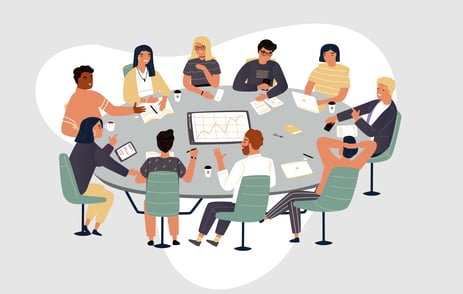Organizations of ALL types – for-profit and tax-exempt – have been talking about digital transformation for many years, and yet association efforts, both to digitize and to go digital, continue to lag.
In The No BS Guide to Digital Transformation: How Intentional Culture Change Can Propel Associations Forward, we posit that it’s all about culture.
A decade of research demonstrates that the key to lasting, responsive digital transformation is intentional and focused culture change. But a lot of that research misses our community because it misses what makes us unique: “associations have both unique advantages and particular challenges we face in trying to transform ourselves, assets and drawbacks that the extensive existing literature on the topic doesn’t really address. Associations have been struggling with digital transformation because the advice that exists on how to do it misses what makes our community special.”
What is digital transformation?
There are all sorts of definitions, depending on the perspective of the definer (marketing, tech, HR, C-suite, etc.). People also tend to define digital transformation too narrowly, as just about the adoption of new technologies and/or as adopting a “digital-first” culture.
The thing is, the challenge associations face in our digital transformation initiatives is that it’s an iterative process that includes both technologies and culture, and our members and other audiences. Associations focus on creating more value for our members and for the professions and industries we serve, which means we need to continuously change the way we work, which means we need to be on the lookout for the tools and technologies that will allow us to do that. And the cycle repeats.
Which sounds, if not easy, then at least simple.
So why aren’t we doing it?
While associations definitely still have work to do on the digitizing front, it’s not technology that’s holding our industry back; it’s culture, and more specifically, culture change.
We tend to think of culture in lofty terms, like we’re collaborative, or we’re forward-thinking, or we’re member-centric. But when it comes to digital transformation, you need beware platitudes and start identifying the specific parts of your culture that will derail your digital transformation efforts.
Such as?
Maybe your collaboration is a little awkward—your departments are siloed and don’t generally share what they’re working on—so how will they now suddenly start sharing data openly on new platform? Perhaps your commitment to innovation is a little more talk than walk—you say you’re forward thinking, but people get punished for taking a risk, at least if it doesn’t pan out—so how are you going to get comfortable experimenting? You need to get your culture ready for this work if you want it to succeed.
As we pointed out, this is why a lot of the copious digital transformation advice that exists don’t quite hit the mark for associations: For-profit culture is fundamentally different than association culture.
On one level, that’s because a member is more than just a customer. But it is also about the intersection of technology and culture. After all, as Maddie is fond of remarking, digital transformation comes down to culture change + vendor selection.
Digital Transformation Technologies
The technologies of digital transformation include:
- Artificial Intelligence (AI)
- Cloud
- Data analytics
- Internet of Things (IoT)
- Mobile
- Social
- Web
On the most basic level, you don’t want a cloud strategy, or an AI strategy, or a social strategy – you need well-thought-out organizational strategy that includes these things. The tech is not the end – it’s the means to the end of accomplishing your larger organizational goals in a member-centric way.
But it’s the culture part that gets really tricky. In order to be successful, you’ll need strong, consistent support from your C-suite (and your board or volunteer leadership), actively providing direction and the resources for that change to happen, and that involves identifying and, as necessary, adjusting your culture patterns.
Where do you start?
Learning about what digital transformation is (and isn’t), why it matters, what barriers are unique to associations, what advantages our industry has – that’s all interesting and useful.
But how do you actually accomplish digital transformation in your association? Maddie and I have you covered.
Here are the 7 steps to accomplish a successful digital transformation:
- Assess where you are now.
- Secure leadership support and a funding commitment.
- Identify strategic areas where digital tech could make a difference.
- Review your legacy systems and processes (make sure you’ve got the “digitizing” part covered, for Ross/Mocker fans).
- Recruit your team.
- Get comfortable with experimenting (for more on how to do this, see the earlier Spark collaborative whitepaper Innovate the Lean Way).
- Improve your culture management.
THEN AND ONLY THEN, chose your tech investments and make it happen.
For more on how to do all that, download the full whitepaper, which includes the definitive answer to the question “Should we build an app?,” multiple case studies and extensive resources for free at https://bit.ly/3y4O6dy.
Tags:
Digital Transformation
June 23, 2021


